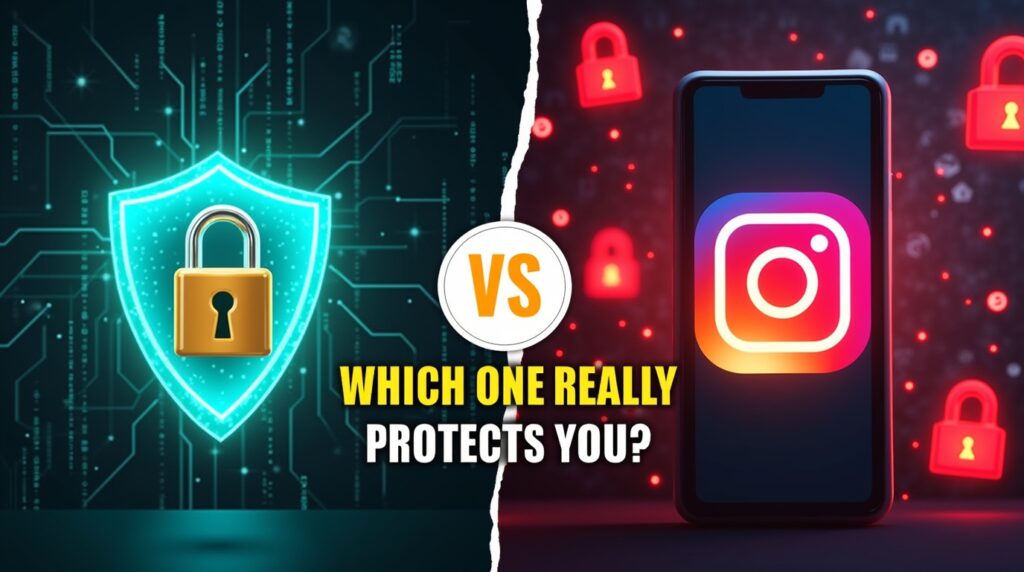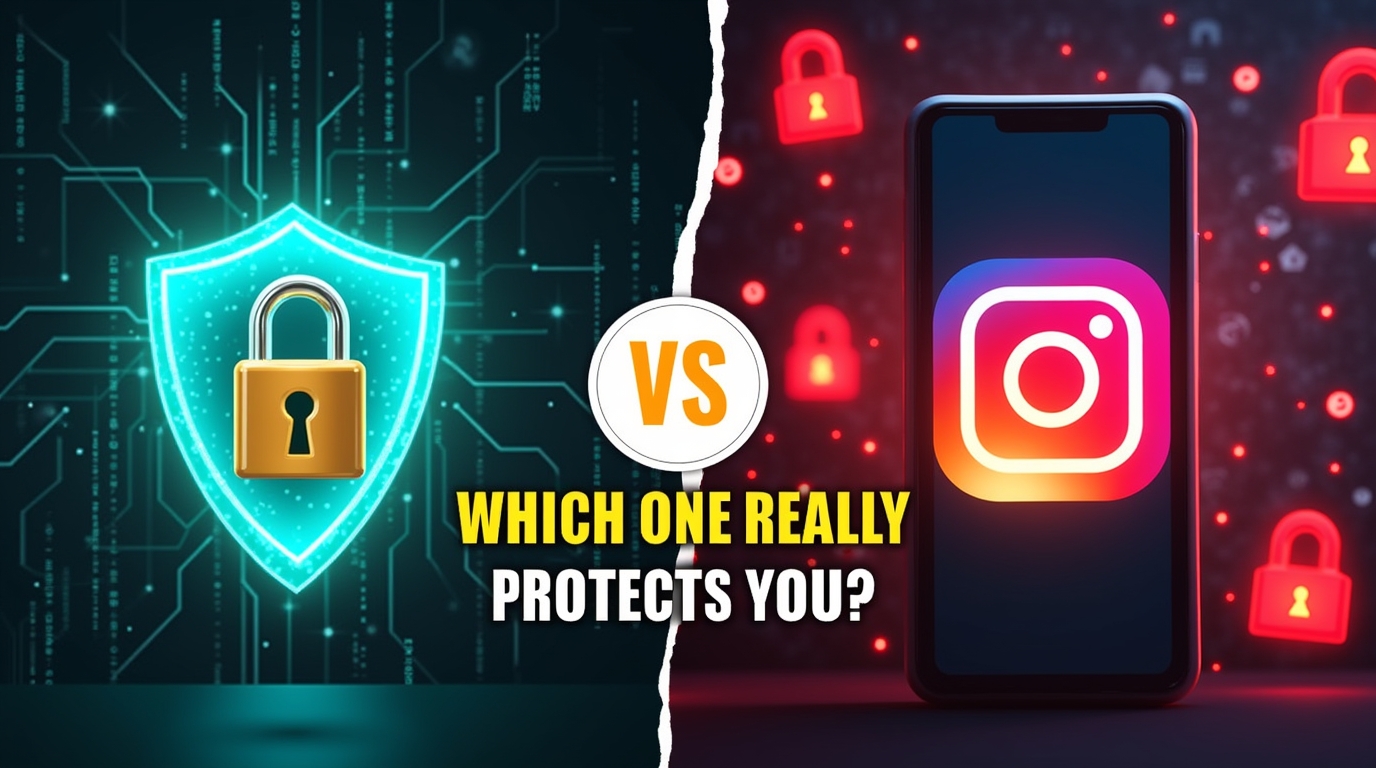Instagram is no longer just a photo-sharing app. It’s a hub for creators, brands, small businesses, and individuals who want to stay connected. With over 2 billion monthly users, Instagram accounts have become valuable digital assets. But this popularity has a dark side: hackers are constantly looking for ways to break in.
That’s why Instagram account security should be a top priority for every user. Whether you’re a casual scroller or a full-time influencer, losing access to your account could mean stolen memories, lost income, or even identity theft.

Two tools are often discussed when it comes to keeping Instagram safe:
- Password managers
- Instagram’s built-in security features (like two-factor authentication)
But which one is more effective? And do you really need both?
Let’s dive deep into this question, explore real-world examples, and give you actionable cybersecurity tips for Instagram that you can start using today.
Password Managers vs. Instagram: Which One Actually Keeps Your Account Safe
Why Instagram Accounts Are Prime Targets for Hackers
Before comparing password managers and Instagram security, it’s important to understand why hackers care so much about social media accounts.
1. Personal Data Theft
Hackers can steal your private messages, email addresses, and even linked phone numbers.
2. Financial Scams
Compromised accounts are often used to promote fake investment schemes or online stores.
3. Identity Hijacking
A hacked Instagram profile can impersonate you, damaging your reputation.
4. Business Disruption
For influencers and brands, losing an account means losing customers and income streams.
Bottom line: Instagram accounts hold both emotional and financial value, making them an attractive target.
The Rise of Password Managers: What They Are and How They Work
A password manager is a tool that securely stores all your passwords in one place. Instead of memorizing dozens of logins, you only need to remember one master password.
Here’s what password managers typically do:
- Generate strong Instagram passwords (long, random, and unique).
- Store them securely using encryption.
- Auto-fill login forms so you don’t type your password every time.
- Warn you about data breaches that expose your credentials.
Popular options include 1Password, Dashlane, LastPass, and Bitwarden.
With a password manager, you don’t have to worry about reusing weak passwords, which is one of the biggest mistakes Instagram users make.
Instagram’s Native Security Features
Instagram provides several built-in protections to help keep your account safe. Let’s break them down.
🔒 Two-Factor Authentication (2FA)
When you enable Instagram 2FA setup, you add a second step to your login. Besides your password, you’ll need a code sent via text or generated by an authentication app.
📲 Login Alerts
Instagram notifies you when there’s a suspicious login attempt from a new device.
🔑 Password Reset Protection
If someone tries to reset your password, Instagram sends you a warning email to confirm it’s really you.
🛡️ Security Checkups
Instagram occasionally prompts users to review login activity, recovery email, and linked phone numbers.
These features are useful, but they rely on you having a strong password in the first place. And that’s where password managers come in.
Password Managers vs. Instagram Security
Now let’s compare the two approaches directly.
| Feature | Password Managers | Instagram Security Features |
|---|---|---|
| Strong password creation | ✅ Yes | ❌ No (user must choose password) |
| Auto-fill & convenience | ✅ Yes | ❌ No |
| Data breach alerts | ✅ Yes | ❌ No |
| Two-factor authentication | ❌ No (but integrates with 2FA apps) | ✅ Yes |
| Login protection | ❌ No | ✅ Yes |
| Password reset protection | ❌ No | ✅ Yes |
Takeaway:
- Password managers strengthen your passwords and protect them from being guessed or leaked.
- Instagram’s security features protect you during the login process and against suspicious activity.
The best protection comes from using both together.
Benefits of Using Password Managers for Instagram
Let’s highlight the main ways password managers improve Instagram account security:
- Unique Passwords for Every Account
- No more reusing the same password across Facebook, email, and Instagram.
- Example: Instead of “Insta123!”, your password manager can create something like “J9!q$8Lx7Yw2.”
- Instant Auto-Fill
- Reduces the chance of typing your password into a phishing site.
- Breach Alerts
- If your Instagram password shows up in a data leak, you’ll know immediately.
- Cross-Device Sync
- Safely log in on phone, tablet, or desktop without remembering every password.
- Added Convenience
- You don’t have to remember complicated strings — your password manager does it for you.
Limitations of Instagram’s Own Security
While Instagram offers strong tools, it’s not perfect. Here are a few gaps:
- No automatic strong password generation. Users often create weak ones.
- Password reuse not monitored. If you use the same password elsewhere, Instagram won’t warn you.
- 2FA setup often skipped. Many users don’t enable it because they find it inconvenient.
- Reliance on user awareness. Security alerts only help if you recognize them and act quickly.
That’s why relying only on Instagram’s tools isn’t enough. Pairing them with a password manager gives you complete protection.
Best Password Managers to Protect Instagram Accounts
Here are some of the best password managers that can help secure your Instagram account:
1. 1Password
- Great for families and teams.
- Built-in data breach monitor (“Watchtower”).
2. Dashlane
- Easy-to-use interface.
- Includes VPN for safe browsing.
3. LastPass
- Free plan available.
- Cloud sync across devices.
4. Bitwarden
- Open-source and affordable.
- Strong community trust.
5. NordPass
- Created by the makers of NordVPN.
- Strong encryption and user-friendly.
Each of these password managers integrates well with Instagram login protection and helps maintain Instagram password safety.
Case Studies & Real-Life Examples
- Case 1: The Reused Password Hack
A fitness influencer lost her Instagram account after hackers used a leaked password from another site. A password manager could have prevented this by generating a unique password. - Case 2: Phishing Attack
A small business owner clicked a fake Instagram login link. Since her password manager didn’t auto-fill, she realized it was a scam and avoided being hacked. - Case 3: Business Account Compromise
A brand’s Instagram got hacked during a brute-force attack. With 2FA and a strong password generated by a manager, this would have been nearly impossible.
Step-by-Step Guide: Setting Up 2FA on Instagram with a Password Manager
You can combine Instagram’s two-factor authentication Instagram setup with your password manager for maximum security. Here’s how:
- Open Instagram app → go to Settings & privacy.
- Select Password and security → Two-factor authentication.
- Choose Authentication App (recommended).
- Copy the setup key provided by Instagram.
- Open your password manager (many have built-in 2FA, e.g., 1Password or Dashlane).
- Add a new 2FA entry and paste the setup key.
- Use your password manager’s 2FA codes to log in securely.
Now, both your password and your 2FA codes are safe in one encrypted vault.
FAQs About Instagram Security & Password Managers
1. Do I really need a password manager for Instagram?
Yes. Password managers create and store strong, unique passwords that you’d never remember on your own.
2. Isn’t Instagram 2FA enough?
2FA is excellent, but if your password is weak or leaked, hackers can still attempt attacks. Combining both is the safest choice.
3. What’s the best free password manager?
Bitwarden is one of the best free, open-source options with strong encryption.
4. Can hackers steal data from password managers?
Reputable managers use end-to-end encryption. Even if their servers are hacked, your data stays safe.
5. Should businesses use password managers for Instagram?
Absolutely. Teams can share account access without sharing the actual password.
Final Verdict: Which One is Safer?
If you had to choose only one, Instagram’s built-in security (especially 2FA) is essential. But password managers add layers of protection Instagram alone cannot provide.
The real winner? Both together.
- Instagram 2FA protects logins.
- Password managers protect passwords.
This combination creates a security shield that’s nearly impossible for hackers to bypass.
Conclusion & Call to Action
Your Instagram account is a gateway to memories, friendships, and even business opportunities. Don’t leave it vulnerable.
- Use a password manager to generate strong, unique logins.
- Enable two-factor authentication Instagram setup today.
- Stay alert for phishing and follow social media security best practices.
👉 The smartest move is combining password managers with Instagram’s native security features. Do this today, and you’ll enjoy peace of mind knowing you’ve built a truly secure Instagram account.

Dilip Chouhan is a passionate content creator from Rajasthan, India. At 22, he has successfully completed his graduation and is dedicated to sharing valuable knowledge and insights through his writing. With a focus on delivering informative, engaging, and reader-friendly content, Dilip aims to help his audience stay updated, inspired, and empowered.
